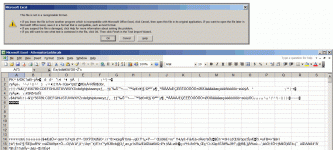Hi friends
I am still struggling to understand the math behind ladder attenuators. I once thought it would be easy, but nope, not really. (Not if following/listeningn to the masters at least).
So I have this cool ladder attenuator calculation sheet from Elma, but it's too cool for me: Why are there those "Ladder (no load)" and "Ladder (with load)" options?
Haven't ever seen anything like that although I've looked at I'd say most of the products available...
I believe Master Salas already explained it (here), but I'm completely overwhelmed.
What Load-impedance should I go with, and — why?
(excel calcsheet included as zip-file)
Thank you
I am still struggling to understand the math behind ladder attenuators. I once thought it would be easy, but nope, not really. (Not if following/listeningn to the masters at least).
So I have this cool ladder attenuator calculation sheet from Elma, but it's too cool for me: Why are there those "Ladder (no load)" and "Ladder (with load)" options?
Haven't ever seen anything like that although I've looked at I'd say most of the products available...
I believe Master Salas already explained it (here), but I'm completely overwhelmed.
What Load-impedance should I go with, and — why?
(excel calcsheet included as zip-file)
Thank you
Attachments
Too cool for me too. Can't read the MacOS "numbers" file. (It is not an "excel".)it's too cool for me:

Picture a 10k simple potentiometer. ASSume a zero source impedance. Put the wiper smack on center. You expect -6.0206 dB. But only NO load. Feed a 2.5k load, now it is -12.0412 dB.
So what are you driving? Can you make it "infinite" compared to this attenuator? Short wire to open grid or a TL072, maybe so.
Ah, thank you, PRR.
You shed some light on it and fed me some brainfood! 🙂
As for the notsocool numbers-format, my bad. Here's an export into .xlsx, which hopefully was converted correctly.
After Aaron from don-audio tried to answer/explain, I realized there's a load-resistor from output to ground (I did not see it before)...
I always regarded stepped attenuators (especially ladder types) as just a more intricate alternative to conventional pots. Now, with this load-option, the game is open again!
I will need time and testboards or similar to approach understanding level. I think I'll just partially build one to touch and see it under current, bzzt 😀
You shed some light on it and fed me some brainfood! 🙂
As for the notsocool numbers-format, my bad. Here's an export into .xlsx, which hopefully was converted correctly.
After Aaron from don-audio tried to answer/explain, I realized there's a load-resistor from output to ground (I did not see it before)...
I always regarded stepped attenuators (especially ladder types) as just a more intricate alternative to conventional pots. Now, with this load-option, the game is open again!
I will need time and testboards or similar to approach understanding level. I think I'll just partially build one to touch and see it under current, bzzt 😀
Attachments
Ah, and it's not over yet. While further researching the matter, I found this calculator: https://rssconsultancy.co.uk/atten.html where the values are being calculated. So far so good, but then, what's that last "resistor"?
Heck, I don't get it.
Heck, I don't get it.
Step 1, Attenuation = Infinity dB, Rx = 25000 ohms, Ry = 0 ohms, Resistor = 0 ohms.
Step 2, Attenuation = 75 dB, Rx = 24996 ohms, Ry = 4 ohms, Resistor = 4 ohms.
Step 3, Attenuation = 69 dB, Rx = 24991 ohms, Ry = 9 ohms, Resistor = 5 ohms.
Step 4, Attenuation = 63 dB, Rx = 24982 ohms, Ry = 18 ohms, Resistor = 9 ohms.
Step 5, Attenuation = 58 dB, Rx = 24969 ohms, Ry = 31 ohms, Resistor = 13 ohms.
Step 6, Attenuation = 53 dB, Rx = 24944 ohms, Ry = 56 ohms, Resistor = 25 ohms.
Step 7, Attenuation = 48 dB, Rx = 24900 ohms, Ry = 100 ohms, Resistor = 44 ohms.
Step 8, Attenuation = 43 dB, Rx = 24823 ohms, Ry = 177 ohms, Resistor = 77 ohms.
- Home
- Source & Line
- Analogue Source
- Ladder Attenuator: Why a calculation with specific load, and even "no load"? (Elma)